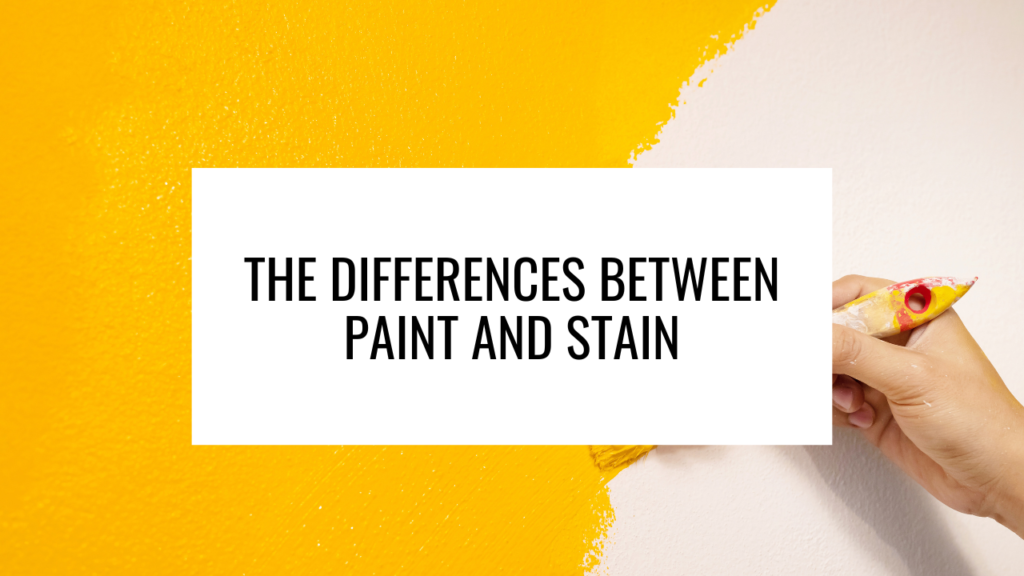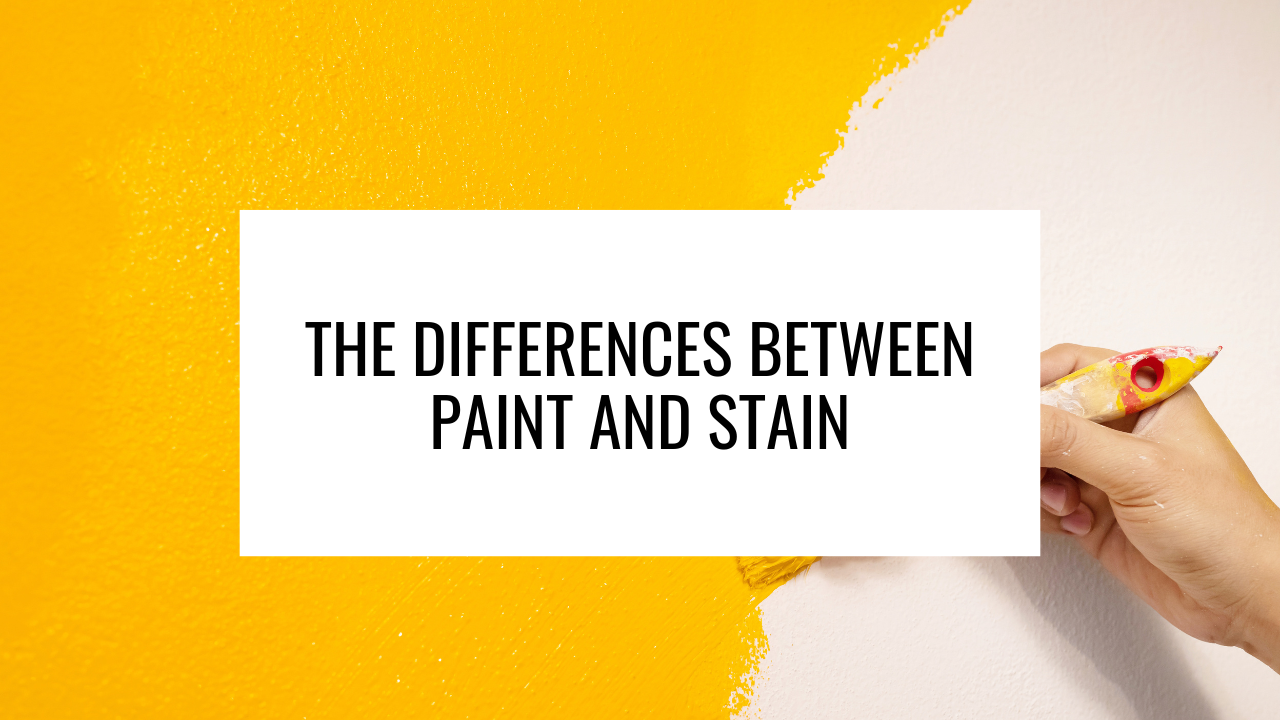Paint and stain are both effective agents concocted to coat walls, furnishings, and various surfaces around your home or business – but what’s the difference between Paint and Stain? They turn drab drywall and faded wood into works of art, revitalized with every brush stroke.
Table of Contents
To help you learn more about the purposes of each option, how they’re applied, and when they’re best used, we put together this comprehensive blog post.

Difference Between Paint and Stain
Paint and stain are primarily used to preserve and upgrade your space. While they may be more widely perceived as a way to decorate surfaces, they also do their part in protecting those surfaces from the elements and expected wear and tear. They also do a great job of enhancing the look of the materials they cover. They take something worn or dull and make it new and riveting.
Composition of Paint and Stain
Both paint and stain are composed of a pigment, solvent, and binder. Stains have more solvent, followed by a pigment or dye, with a final touch of binder. Paint goes heavier on the binder, helping it stick to every surface it encounters.
Varieties of Paint and Stain
Like paint, stain comes in a variety of finishes, but not quite as many.
When shopping for paint, you’ll likely find some of the following finishes:
- Matte (more pigment, low level of sheen)
- Satin (mid-levels of sheen)
- Eggshell (durable, low sheen)
- Semi-gloss (slightly glossy/shiny appearance, more so than satin)
- Gloss (shiny)
Alternatively, when you shop for stain, you might encounter these finishes:
- Matte
- Satin
Plus, the following types of opacity:
- Solid
- Semi-transparent
- Clear
Opacity types account for how concentrated the stain will be. In other words, how deep and visible the dye will be.
Choosing which type of paint or stain you want comes down to the aesthetic you’re going for. If you want something flashy, opt for a satin or glossy finish. If you’re looking for something more subdued, a matte finish is your best friend.
Applying Paint and Stain
Now that you’re well-versed on everything that gets stirred into paint and stain, plus the different ways they’re presented, it’s time to talk about each agent’s application process.
Paint Application
Paint is a little more high-maintenance. It typically needs to be placed upon a primed surface. Unlike stain, paint sits on top of the surface and requires multiple coats to reach its optimal state – this also means that a paint project might be more time-consuming. Luckily though, paint covers surfaces more cohesively (as opposed to stain).
If the surface you’re painting is particularly porous, you may need to use more paint than you anticipated.
Stain Application
In contrast to paint, stain is made to seep into the surface it’s applied to. Conveniently, stain doesn’t require any primer and it typically only calls for one coat – making the application process much quicker.
If a surface has been painted, it cannot be stained, unless it’s been properly stripped. On the other hand, a surface that’s been stained can be painted, as long as it’s been appropriately prepped.
When to Use Paint
If you want to make a bolder statement, pick paint over stain. Contrary to stain, you can paint several different types of surfaces, including drywall, stucco, plastic, and metal.
Here’s an overview of when paint would work best over stain in a couple of scenarios:
Drywall
Drywall is better painted than stained because stain drenches the drywall and accumulates spots through patchy application. When you paint drywall, you seamlessly cover any imperfections, adding pleasing protective layers.
Vinyl
Vinyl is another material that’s best painted. It’s nonporous, so it doesn’t provide the proper absorption stain requires, unless maybe you use a thick gel-stain variety. Ultimately, vinyl is a better canvas for paint, and in some cases, it doesn’t even need to be primed. You will, however, want to make sure you clean it thoroughly prior to your paint project. Let everything dry before beginning.
When to Use Stain
There are a few specified surfaces that benefit best from stain, they include:
Wood
Stain is best applied to wood. While wood can also be painted, paint cloaks the entire integrity and texture of the natural material, whereas stain redefines it. Stain also has the tendency to protect the wood it soaks into. It seals everything up, preventing any moisture from being absorbed.
It’s important to note that wood stain will eventually fade and will require a touch-up here and there – which is still much simpler than some of the maintenance paint requires.
Masonry and Brick
Masonry and brick can also be painted, but once again, staining helps to preserve the natural composition of these materials. Best done professionally, staining masonry and brick also enables airflow (since the pores remain unblocked), which allows moisture to flee freely.
Concrete
Technically, you can paint or stain concrete, but the best way to upgrade this type of surface is to stain it.
Paint will simply coat the concrete, gradually peeling and flaking off as time goes by.
Stain actually sets into the concrete, especially when it’s acid-based. This stain composition is best suited for floors.
If you have a horizontal concrete surface in need of upgrading, then you can opt for a water-based stain instead.
Pros of Paint
Based on everything we’ve covered so far, here’s a breakdown of the overall benefits of paint:
- There are more paint varieties to choose from (tons of finishes, sheens, and colours available)
- You can successfully paint more surfaces (less stubborn than stain)
- You can paint over previously painted walls once they’ve been prepped, whereas you cannot stain them
- When applied properly in the appropriate amount of coats, paint provides a more uniform appearance
Pros of Stain
Likewise, let’s revisit all the benefits of stain so you can leave better equipped to make an informed decision:
- Stain is often the more affordable option since you’ll require more coats of paint and primer when painting
- Stain is simpler and faster to apply (whether initially or for touch-ups), and it typically requires less coats, no primer, and less time to dry
- It lets the natural essence of the surface shine through (particularly with natural materials like wood)
- While stain will eventually fade (although it usually lasts longer than paint), it’s still more durable (paint tends to crack, peel, and flake over time)
Conclusion
The main difference between paint and stain is that paint sits on top of a surface whereas stain sinks into the surface. These behaviours dictate which surfaces work best for each agent.
Paint can be applied to virtually any surface, as long as you’re okay with concealing any natural character of the material beneath it.
Stain is best applied to porous material like wood and enhances natural features without covering everything up.
For a professional application of your next paint or stain project, reach out to Sarson Painting & Wallcoverings today for a quote.

